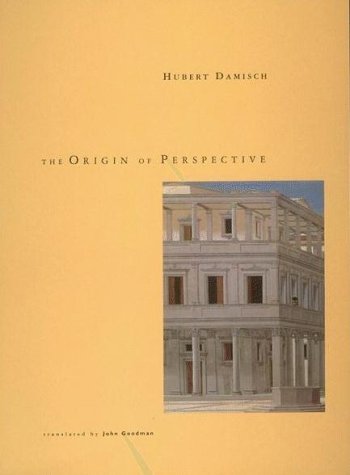Hubert Damisch: The Origin of Perspective (1987–) [EN, CR]
Filed under book | Tags: · architecture, art, art history, art theory, geometry, history of architecture, mirror, painting, perspective, renaissance, representation, space, theatre

“In part a response to Panofsky’s Perspective as Symbolic Form, The Origin of Perspective is much more. In France it is considered one of the most important works of art history to have appeared in the last twenty years. With the exception of Michel Foucault’s analysis of Las Meninas, it is perhaps the first time a structuralist method such as the one developed by Claude Lévi-Strauss in The Way of the Masks has been thoroughly and convincingly applied to Western art.
The task Damisch has set for himself is to refute both the positivist critics, whose approach makes up the bulk of perspective studies and is based on a complete repression of Panofsky’s early work, and the current pseudo-avant-gardist position (whether in the field of cinema studies or in literary criticism), which tends to disregard facts and theoretical analysis. Damisch argues that if a theoretical analysis of perspective is possible, using all the tools of structuralist semiotics, it is only possible in the context of a close look at its appearance in history, beginning with the details of the ‘invention’ of perspective.”
Originally published in French as L’Origine de la perspective, Flammarion, Paris, 1987.
Translated by John Goodman
Publisher MIT Press, 1994
ISBN 0262041391, 9780262041393
477 pages
Review: Wood (The Art Bulletin, 1995).
Commentary: Iversen (Oxford Art Journal, 2005).
WorldCat (EN)
The Origin of Perspective (English, 1994, chapter 14 missing, 24 MB, no OCR)
Porijeklo perspektive (Croatian, trans. Zlatko Wurzberg, 2006, added on 2018-7-8)
L. D. Reynolds, N. G. Wilson: Scribes and Scholars: A Guide to the Transmission of Greek and Latin Literature (1968/1991)
Filed under book | Tags: · antiquity, book, history, history of literature, literature, middle ages, print, publishing, renaissance, scholarship, textual criticism, transmission of texts, writing

“One of the remarkable facts about the history of Western culture is that we are still in a position to read large amounts of the literature produced in classical Greece and Rome despite the fact that for at least a millennium and a half all copies had to be produced by hand and were subject to the hazards of fire, flood, and war. This book explains how the texts survived and gives an account of the reasons why it was thought worthwhile to spend the necessary effort to preserve them for future generations.
In the second edition a section of notes was included, and a new chapter was added to deal with some aspects of scholarship since the Renaissance. In the third edition, the authors responded to the urgent need to take account of the very large number of discoveries in this rapidly advancing field of knowledge by substantially revising or enlarging certain sections.”
Publisher Clarendon Press, Oxford, 1968
Third edition, 1991
ISBN 0198721463, 9780198721468
352 pages
Review (of 2nd ed., E. Christian Kopff, The Classical Journal, 1976)
Review (M. Possanza, Bryn Mawr Classical Review, 1991)
PDF (12 MB)
Comment (0)Mark Rothko: The Artist’s Reality: Philosophies of Art (2004)
Filed under book | Tags: · abstraction, art, art theory, beauty, colour, environment, light, myth, painting, philosophy of art, reality, renaissance, representation, space, symbolism

“One of the most important artists of the twentieth century, Mark Rothko (1903–1970) created a new and impassioned form of abstract painting over the course of his career. Rothko also wrote a number of essays and critical reviews during his lifetime. Although the artist never published a book of his views, his heirs indicate that he occasionally spoke of the existence of such a manuscript to friends and colleagues. Stored in a New York City warehouse since the artist’s death more than thirty years ago, this manuscript, titled The Artist’s Reality, is now being published for the first time.
Probably written around 1940–41, this book discusses Rothko’s ideas on the modern art world, art history, myth, beauty, the challenges of being an artist in society, the true nature of “American art,” and much more. The Artist’s Reality also includes an introduction by Christopher Rothko, the artist’s son, who describes the discovery of the manuscript and the process of bringing it to publication. The introduction is illustrated with a small selection of relevant examples of the artist’s own work as well as with reproductions of pages from the actual manuscript.”
Edited and with an Introduction by Christopher Rothko
Publisher Yale University Press, 2004
ISBN 0300115857, 9780300115857
136 pages

